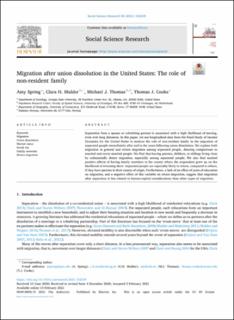| dc.contributor.author | Spring, Amy | |
| dc.contributor.author | Mulder, Clara H. | |
| dc.contributor.author | Thomas, Michael J. | |
| dc.contributor.author | Cooke, Thomas J. | |
| dc.date.accessioned | 2022-03-22T19:20:37Z | |
| dc.date.available | 2022-03-22T19:20:37Z | |
| dc.date.created | 2021-02-17T16:34:26Z | |
| dc.date.issued | 2021-02 | |
| dc.identifier.citation | Social Science Research, Volume 96, May 2021, 102539. | en_US |
| dc.identifier.issn | 0049-089X | |
| dc.identifier.uri | https://hdl.handle.net/11250/2986907 | |
| dc.description.abstract | Separation from a spouse or cohabiting partner is associated with a high likelihood of moving, even over long distances. In this paper, we use longitudinal data from the Panel Study of Income Dynamics for the United States to analyze the role of non-resident family in the migration of separated people immediately after and in the years following union dissolution. We explore both migration in general and return migration among separated people, drawing comparisons to married and never-married people. We find that having parents, children, or siblings living close by substantially deters migration, especially among separated people. We also find marked positive effects of having family members in the county where the respondent grew up on the likelihood of returning there. Separated people are especially likely to return, compared to others, if they have parents in their county of origin. Furthermore, a lack of an effect of years of education on migration, and a negative effect of this variable on return migration, suggest that migration after separation is less related to human-capital considerations than other types of migration. | en_US |
| dc.language.iso | eng | en_US |
| dc.publisher | Elsevier | en_US |
| dc.rights | Navngivelse-Ikkekommersiell-DelPåSammeVilkår 4.0 Internasjonal | * |
| dc.rights.uri | http://creativecommons.org/licenses/by-nc-sa/4.0/deed.no | * |
| dc.title | Migration after union dissolution in the United States: The role of non-resident family | en_US |
| dc.type | Peer reviewed | en_US |
| dc.type | Journal article | en_US |
| dc.description.version | publishedVersion | en_US |
| dc.rights.holder | © 2021 The Author(s). Published by Elsevier Inc. This is an open access article under the CC BY license. | en_US |
| dc.subject.nsi | VDP::Samfunnsvitenskap: 200::Sosiologi: 220 | en_US |
| dc.source.journal | Social Science Research | en_US |
| dc.identifier.doi | 10.1016/j.ssresearch.2021.102539 | |
| dc.identifier.cristin | 1891022 | |
| dc.source.articlenumber | 102539 | en_US |
| cristin.ispublished | true | |
| cristin.fulltext | original | |
| cristin.fulltext | original | |
| cristin.qualitycode | 2 | |

